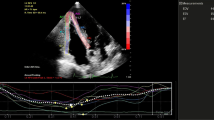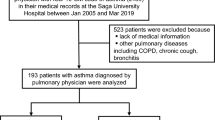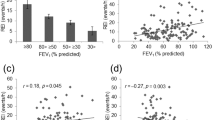Abstract
OBJECTIVE: To determine the point prevalence of pulmonary hypertension (PH) and its relationship with respiratory disturbances in obese patients living at moderate altitude.
SUBJECTS: A total of 57 obese patients comprised the final sample and consisted of 34 women and 23 men, with a mean age of 42.7±12.1 ys and a mean body mass index (BMI) 47.1±10.6 kg/m2 (range from 30.1 to 76.1). The mean living altitude was 2248.7 m, range 2100–2400 m above sea level.
MEASUREMENTS: Doppler echocardiography, pulmonary function tests, arterial blood gas analysis, and polysomnography were performed.
RESULTS: Data showed that 96.5% of the studied sample had daytime PH defined as calculated systolic pulmonary artery pressure (PSAP) >30 mmHg (mean PSAP=50, s.d.=13 mmHg). The severity of diurnal PH was found to be related to the presence of alveolar hypoventilation and BMI. The main risk factor for severity of diurnal PH was hypoventilation with a significant odds ratio (OR) 7.96, 95% CI 1.35–46.84, BMI was (OR 1.12, 95% CI 1.02–1.25) and apnea/hypopnea index was not a predictor of pulmonary hypertension severity (OR 0.99, 95% CI 0.97–1.02).
CONCLUSION: We concluded that prevalence of diurnal PH is high in obese patients living at moderate altitude, and that hypoventilation is the main risk factor associated with the severity of pulmonary hypertension.
This is a preview of subscription content, access via your institution
Access options
Subscribe to this journal
Receive 12 print issues and online access
$259.00 per year
only $21.58 per issue
Buy this article
- Purchase on Springer Link
- Instant access to full article PDF
Prices may be subject to local taxes which are calculated during checkout
Similar content being viewed by others
References
Podszus T . Pulmonary hemodynamics in sleep-related breathing disorders. In: Smirne S, Franceschi M, Ferini Strambi L (eds). Sleep and ageing. Masson: Milano; 1991. pp 122–134.
Marrone O, Bellia V, Ferrara G, Milone F, Romano L, Salvaggio A, Stallone A, Bonsignore G . Transmural pressure measurements. Importance in the assessment of pulmonary hypertension in obstructive sleep apneas. Chest 1989; 95: 338–342.
Marrone O, Bonsignore MR, Romano S, Bonsignore G . Slow and fast changes in transmural pulmonary artery pressure in obstructive sleep apnoea. Eur Respir J 1994; 7: 2192–2198.
Weitzenblum E, Krieger J, Apprill M, Vallée E, Ehrhart M, Ratomaharo J, Oswald M, Kurtz D . Daytime pulmonary hypertension in patients with obstructive sleep apnea syndrome. Am Rev Respir Dis 1988; 138: 345–349.
Sajkov D, Cowie RJ, Thornton AT, Espinoza HA, McEvoy RD . Pulmonary hypertension and hypoxemia in obstructive sleep apnea syndrome. Am J Respir Crit Care Med 1994; 149: 416–422.
Laks L, Lehrhaft B, Grunstein RR, Sullivan CE . Pulmonary hypertension in obstructive sleep apnoea. Eur Respir J 1995; 8: 537–541.
Chaouat A, Weitzenblum E, Krieger J, Oswald M, Kessler R . Pulmonary hemodynamics in the obstructive sleep apnea syndrome. Results in 220 consecutive patients. Chest 1996; 109: 380–386.
Krieger J, Sforza E, Apprill M, Lampert E, Weitzenblum E, Ratomaharo J . Pulmonary hypertension, hypoxemia, and hypercapnia in obstructive sep apnea patients. Chest 1989; 96: 729–737.
Burwell CS, Robin ED, Whaley RD, Bickelmann AG . Extreme obesity associated with alveolar hypoventilation—A Pickwickian syndrome. Am J Med 1956; 21: 811–818.
Gastaut H, Tassinari CA, Duron B . Etude polygraphique des manifestations épisodiques (hypniques et respiratoires) du syndrome de Pickwick. Rev Neurol (Paris) 1965; 112: 568–579.
Collop NA . Refractory hypoxemia in a morbidly obese 28-year-old woman. Chest 1996; 109: 1101–1102.
Kessler R, Chaouat A, Weitzenblum E, Oswald M, Ehrhart M, Apprill M, Krieger J . Pulmonary hypertension in the obstructive sleep apnoea syndrome: prevalence, causes and therapeutic consequences. Eur Respir J 1996; 9: 787–794.
Alchanatis M, Tourkohoriti G, Kakouros S, Kosmas E, Podaras S, Jordanoglou JB . Daytime pulmonary hypertension in patients with obstructive sleep apnea. Respiration 2001; 68: 566–572.
Bady E, Achkar A, Pascal S, Orvoen-Frija E, Laaban JP . Pulmonary arterial hypertension in patients with sleep apnoea syndrome. Thorax 2000; 55: 934–939.
Lupi-Herrera E, Seoane M, Sandoval J, Casanova JM, Bialostozky D . Behavior of the pulmonary circulation in the grossly obese patient. Pathogenesis of pulmonary arterial hypertension at an altitude of 2,240 meters. Chest 1980; 78: 553–558.
Report of a WHO consultation on obesity. WHO/NUT/NCD/98.1. World Health Organization; 1998.
Expert Committee on the Diagnosis and Classification of Diabetes Mellitus. Committee Report. Diabetes Care 1997; 20: 1183–1197.
Valencia-Flores M, Orea A, Castaño VA, Resendiz M, Rosales M, Rebollar V, Santiago V, Gallegos J, Campos RM, González J, Oseguera J, García-Ramos G, Bliwise DL . Prevalence of sleep apnea and electrocardiographic disturbances in morbidly obese patients. Obesity Res 2000; 8: 262–269.
Pérez Martínez SO, Pérez-Padilla JR . Valores gasométricos en sujetos sanos reportados en la población mexicana: revisión y análisis. Rev Inv Clin 1992; 44: 353–362.
Sajkov D, Cowie RJ, Bradley JA, Mahar L, McEvoy RD . Validation of new pulsed doppler echocardiographic techniques for assessment of pulmonary hemodynamics. Chest 1993; 103: 1348–1353.
Mcgoon MD . The assessment of pulmonary hypertension. In: Rich S, McLaughlin VV (eds). Pulmonary hypetension. Clin Chest Med 2001; 22: 493–507.
Bossone E, Rubenfire M, Bach DS, Ricciardi M, Armstrong WF . Range of tricuspid regurgitation velocity at rest and during exercise in normal adult men: implications for the diagnosis of pulmonary hypertension. J Am Coll Cardiol 1999; 33: 1662–1666.
Fishman AP . Pulmonary Hypertension. In: Schlant RC, Alexander WR (eds). The Heart, arteries and veins. McGraw-Hill, Inc.: New York; 1994. pp 1857–1874.
Schoene RB, Hornbein TF . High altitude adaptation. In: Murray JF, Nadel JA. (eds). Respiratory medicine. WB Saunders Company: Philadelphia; 1988. pp 196–220.
Reeves JT, Grover RF . High-altitude pulmonary hypertension and pulmonary edema. In: Yu PN, Goodwin JF (eds). Progress in cardiology. Lea and Febiger: Philadelphia; 1975. pp 99–118.
deMicheli A, Villacis E, Guzzy de la Mora P, Rubio Alvarez V . Observaciones sobre los valores hemodinamicos y respiratorios obtenidos en sujetos normales. Arch Inst Cardiol 1960; 30: 507–520.
Reynolds T . The echocardiographer's pocket reference. Arizona Heart Institute: Phoenix, Arizona; 1995. pp 134.
American Thoracic Society. Standardization of spirometry. 1994 update. Am J Respir Crit Care Med 1995. 1107–1136.
Kinsman TA, Hahn AG, Gore CJ, Wilsmore BR, Martin DT, Chow CM . Respiratory events and periodic breathing in cyclists sleeping at 2,650-m simulated altitude. J Appl Physiol 2002; 92: 2114–2118.
Allemann Y, Sartori C, Lepori M, Pierre S, Melot C, Naeije R, Scherrer U, Maggiorini M . Echocardiographic and invasive measurements of pulmonary artery pressure correlate closely at high altitude. Am J Physiol Heart Circ Physiol. 2000; 279: H2013–H2016.
Acknowledgements
This investigation received support from National Autonomous University of México DGAPA-IN207397, IN209500, and NIH AG-10643. We thank to Rogelio Perez-Padilla, MD for his critical review on the manuscript.
Author information
Authors and Affiliations
Corresponding author
Rights and permissions
About this article
Cite this article
Valencia-Flores, M., Rebollar, V., Santiago, V. et al. Prevalence of pulmonary hypertension and its association with respiratory disturbances in obese patients living at moderately high altitude. Int J Obes 28, 1174–1180 (2004). https://doi.org/10.1038/sj.ijo.0802726
Received:
Revised:
Accepted:
Published:
Issue Date:
DOI: https://doi.org/10.1038/sj.ijo.0802726
Keywords
This article is cited by
-
Obesity: An Impact with Cardiovascular and Cerebrovascular Diseases
Indian Journal of Clinical Biochemistry (2024)
-
Influence of gender in monocrotaline and chronic hypoxia induced pulmonary hypertension in obese rats and mice
Respiratory Research (2020)
-
Evaluation of right ventricular performance and impact of continuous positive airway pressure therapy in patients with obstructive sleep apnea living at high altitude
Scientific Reports (2020)
-
The influence of obstructive sleep apnea on right ventricular strain: do not forget mechanics!
Journal of Human Hypertension (2020)
-
Right ventricular geometry and mechanics in patients with obstructive sleep apnea living at high altitude
Sleep and Breathing (2016)



